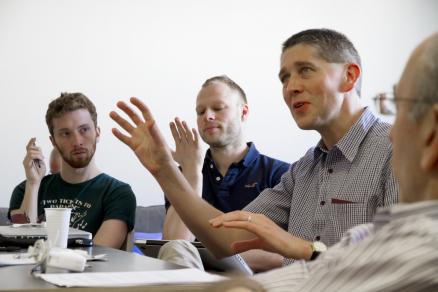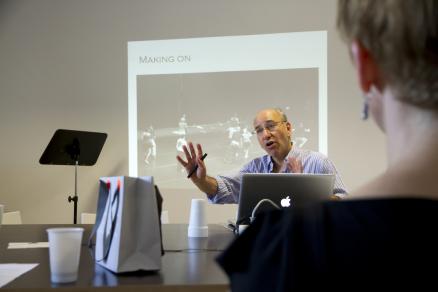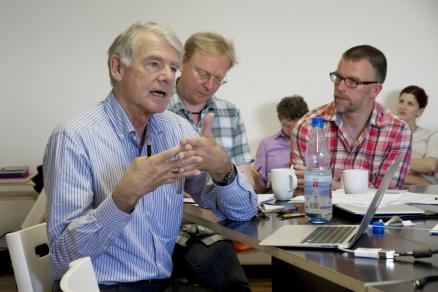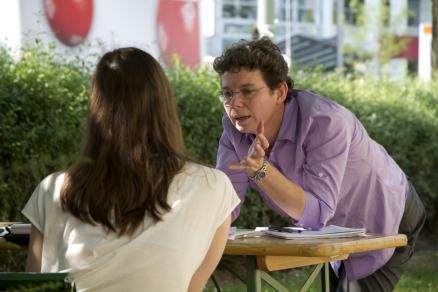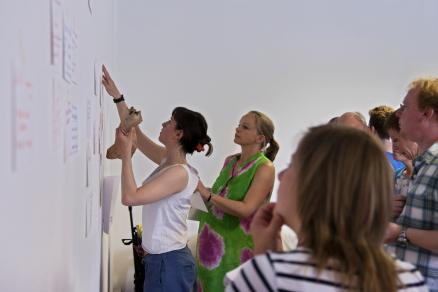Dance Engaging Science Workshop No. 1
Dance Engaging ScienceWorkshop No.1For the first meeting 20-22 May 2011, the following were present: Michael Steinbusch, Kate Stevens, Patrick Haggard, David Kirsh, Emily Cross, Alva Noë, James Leach, Bettina Blaesing. The group expanded to include Associate Researchers and Guests: Guido Orgs, Freya Vass-Rhee, Elizabeth Waterhouse, Riley Watts, Kurt Koegel and Anke Euler. Research Advisor Wolf Singer was present. Martin Streit provided video documentation. See the Dance Engaging Science pages for individual affiliations. |
|
|
Prior to the first meeting a Reader consisting of 25 articles was compiled for the Workgroup. The material covered the most important scientific and scholarly topics already articulated for the project including choreographic (study) objects, social modes of creativity, bodily attention and awareness, memory and learning, choreographic cognition and perception of the audience as well as essays by performers with The Forsythe Company (see Reader Content List). |
|
|
The meeting began Friday afternoon with presentations from Leach, Cross, Haggard, Orgs, Steinbusch and Stevens about their dance-related research. The day closed with Vass-Rhee presenting how The Forsythe Company works and why the choreographer William Forsythe is approaching scientists. Saturday the individual presentations wrapped up with Kirsch, Blaesing, Noë and Singer finishing before mid-day. |
|
|
Prior to the meeting, Dana Caspersen provided a document called “Questions From Practice” edited from interviews with The Forsythe Company performers. The purpose: to provide the Workgroup with questions the performers have about their experience making and performing dances. Following the Saturday morning presentations, Vass-Rhee opened a discussion about this document. This stimulated a dialogue between the group and Waterhouse, Vass-Rhee and Watts about how they work in creation and performance and included a demonstration by Watts. |
|
|
Saturday closed with a discussion about possible research questions and areas the group shared. On Sunday, the decision was made to work with cards taped on the wall as a way of further developing the research questions discussed Saturday. By the end of the session Sunday afternoon the group had succeeded in articulating five research topics with clusters under the headings: Attention, Tasks, Acoustics/ Musicality, Expertise, Memory & Learning. Each person in the group signed up for the clusters they were interested in pursuing. |
|
For more details on the meeting, see the Interim Report (November 2012) prepared for the Volkswagen Foundation covering Dance Engaging Science Interdisciplinary Research Workshops Meetings 1-3. Additional documentation: 1) News Report on the Volkswagen Foundation website; 2) A four-page story from IMPULSE 13, the Foundation's regular periodical (in German only).
Dance Engaging Science Documentation:
http://motionbank.org/en/content/dance-engaging-science
http://motionbank.org/en/event/dance-engaging-science-workshop-no-1
http://motionbank.org/en/event/dance-engaging-science-workshop-no-2
http://motionbank.org/en/event/dance-engaging-science-workshop-no-3
http://motionbank.org/en/event/tanzkongress-deborah-hay-beta-release-workshops
INFO
As a response to the COVID-19 / Corona situation we just opened our research system (including Piecemaker and MoSys) for dance education and practice.
This year Motion Bank celebrates it's 10 anniversary. As soon as it becomes possible to make final plans we will release information about these.
Please consider subscribing to our newsletter.

